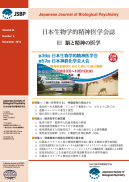Volume 24, Issue 4
Displaying 1-16 of 16 articles from this issue
- |<
- <
- 1
- >
- >|
-
2013Volume 24Issue 4 Pages 177
Published: 2013
Released on J-STAGE: February 16, 2017
Download PDF (123K) -
2013Volume 24Issue 4 Pages 179-184
Published: 2013
Released on J-STAGE: February 16, 2017
Download PDF (361K) -
2013Volume 24Issue 4 Pages 185-190
Published: 2013
Released on J-STAGE: February 16, 2017
Download PDF (308K) -
2013Volume 24Issue 4 Pages 191-199
Published: 2013
Released on J-STAGE: February 16, 2017
Download PDF (471K) -
2013Volume 24Issue 4 Pages 200-210
Published: 2013
Released on J-STAGE: February 16, 2017
Download PDF (804K) -
2013Volume 24Issue 4 Pages 211-217
Published: 2013
Released on J-STAGE: February 16, 2017
Download PDF (346K) -
2013Volume 24Issue 4 Pages 218-221
Published: 2013
Released on J-STAGE: February 16, 2017
Download PDF (241K) -
2013Volume 24Issue 4 Pages 222-227
Published: 2013
Released on J-STAGE: February 16, 2017
Download PDF (290K) -
2013Volume 24Issue 4 Pages 229-234
Published: 2013
Released on J-STAGE: February 16, 2017
Download PDF (260K) -
2013Volume 24Issue 4 Pages 235-240
Published: 2013
Released on J-STAGE: February 16, 2017
Download PDF (299K) -
2013Volume 24Issue 4 Pages 241-245
Published: 2013
Released on J-STAGE: February 16, 2017
Download PDF (323K) -
2013Volume 24Issue 4 Pages 246-251
Published: 2013
Released on J-STAGE: February 16, 2017
Download PDF (347K) -
2013Volume 24Issue 4 Pages 252-256
Published: 2013
Released on J-STAGE: February 16, 2017
Download PDF (300K) -
2013Volume 24Issue 4 Pages 257
Published: 2013
Released on J-STAGE: February 16, 2017
Download PDF (149K) -
2013Volume 24Issue 4 Pages 258
Published: 2013
Released on J-STAGE: February 16, 2017
Download PDF (141K) -
2013Volume 24Issue 4 Pages 259
Published: 2013
Released on J-STAGE: February 16, 2017
Download PDF (140K)
- |<
- <
- 1
- >
- >|
